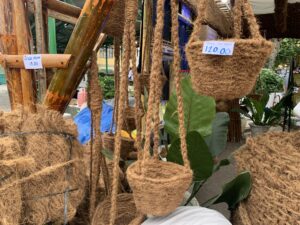CEBU CITY, Philippines — Since the Philippines is a tropical country, coconut is among its primary crops.
The coconut industry is one of the vital sectors of agriculture in the country.
According to Philippine Council for Agriculture, Aquatic and Natural Resources Research and Development (PCAARRD), sectoral council of the Department of Science and Technology (DOST), there are 69 out of 82 provinces in the Philippines that are producing coconut.
Moreover, PCAARRD also stated in its official website that “among the Association of Southeast Asian Nations (ASEAN) countries, the Philippines is ‘the second largest producer of coconut’ comprising “almost 40 percent ASEAN’s total coconut production.”
CALABARZON, Zamboanga Peninsula, Davao, and Northern Mindanao are considered the major coconut-producing regions in the Philippines, PCAARRD said.
Although Cebu is not on the list, the coconut products sold by the people of Pinamungajan showed that coconuts are among the primary sources of income of Cebuanos, anywhere you go in the province.
The coconut products you are already familiar with might be the buko juice (made from coconut water), bukayo (sweet dessert from coconut strips), coconut oil, and desiccated coconut to name a few.
However, the locals in Pinamungajan town in southwestern Cebu offered coconut products that some of you might not be familiar with.
These products are all made from coconut fiber or “bunot” in Cebuano:
Geonet
Landslides often occur anywhere in the country. It could bring damage to residents in a certain area. To combat this, locals in Pinamungajan produce their so-called “geonet.”
Geonet is a combination of the word “geo,” which means earth, and “net,” a material usually made from woven threads.
Geonets are woven coco fiber that are placed and used to cover the side of the mountain to help prevent landslides, according to Rogelito Tanjay, maker and seller of geonet for six years already.

Rogelito Tanjay, seller and maker of geonet for six years already, shared with CDN Digital about its purpose and other uses. CDN Digital photo | Niña Mae C. Oliverio
“Mupogong siya para dili mudahilig [ang yuta],” Tanjay told CDN Digital. (It stops soil from eroding.)
The geonets are sold for P3,000 for a length of 50 meters and width of one meter.
However, even if it is sold and originated in Pinamungajan, this product is crafted in Mohon, Colonia Tuburan, Cebu, where their plant is located, said Tanjay.
“Extension lang to siya didto (Tuburan),” he said. (That is just an extension.)
Tuburan is still in western Cebu, around 80 kilometers north of Pinamungajan.
A single roll of geonet weighs about 40 to 50 kilos.
And besides protection from landslides, geonets can also be used as home decorations, Tanjay said.
Their sales depend on the number of orders they receive on a daily basis, and usually they can sell at least 40 rolls of geonets in a day. However, there are also times where they could not sell a single one.
Geonets can last up to seven to eight years, according to Tanjay. Best of all, it is organic and not harmful to the environment.
Coconut sugar
The most common type of sugar is the one made from sugar canes. But, did you know that you can also produce sugar from coconuts?
The process of making this coconut sugar is similar to the process of making muscovado sugar, according to Jesson Tamundoc, representative of Coco Hub, which is a project of Philippine Coconut Authority (PCA) in partnership with a community-based organization in Brgy. Lamac in Pinamungajan.

Jesson Tamundoc explained to CDN Digital the process of making coconut sugar. He also said that their coconut products are available as well in Parian, Cebu City. CDN Digital photo | Niña Mae C. Oliverio
He said that PCA is the entity that introduced the product to them.
Tamundoc told CDN Digital that its process is done by boiling the coconut sap for three to four hours until it becomes pulverized.
They are selling coconut sugar for P95 per 250 grams, which is also available in Parian in Cebu City.
“Taud-taud na ni siya na establish [coconut sugar product] pero ang iyang production nga medyo daghan nag start 2020,” Tamundoc said. (This has been established for some time now but its mass production started in 2020.)
Coconut sugar’s sweetness is still similar to the ones made from sugar canes. But, Tamundoc said, the sugar content of coconut sugar is lesser.
Other products
Also being sold in Pinamungajan are coconut rope, which is priced at P17 per 15 to 17 meters; hanging coco basket, which sells for P120; and a three-feet coco pole, which is pegged at P100.

Hanging coco basket and coconut rope are displayed in the coconut stall during the Suroy Suroy Sugbo: Explore the Midwest in Pinamungajan. CDN Digital photo | Niña Mae C. Oliverio

Three-feet coconut poles are displayed inside the stall selling coconut products in Pinamungajan town during the midwest getaway of Suroy Suroy Sugbo 2023. CDN Digital photo | Niña Mae C. Oliverio
Suroy Suroy Sugbo in the midwest
Pinamungajan is one of the seven localities part of the third leg of Suroy Suroy Sugbo 2023, where participants got the opportunity to explore the midwestern part of the province of Cebu.
The midwest excursion was held from June 10 to 12, 2023.
On its second day, June 11, the last stop of the tour was in Pinamungajan and the town’s locals took the chance to introduce their various products, including the coconut products to the participants of the midwest adventure.
The other localities in the tourism event was Tabuelan, Tuburan, Asturias, Aloguinsan, Balamban, and Toledo City.
/bmjo

